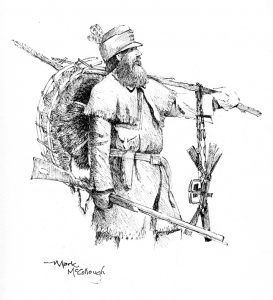Decline in Woodsmanship

By Hal Blood
As I said in my last column, I’m amazed at how many hunters today can’t even use a compass. That is why very few hunters venture more than a quarter of a mile from a road.
Last month I wrote about the lack of navigation skills that keeps a lot of hunters from venturing into the Big Woods. Well, I’m afraid to say that I think woodsmanship skills are becoming a thing of the past for most hunters as well. It seems as though there is a whole generation of new hunters who do not know many of these skills. In the past hunting was a rite of passage that was taken more seriously than it is today. In the past a young hunter was taken afield usually by their father, grandfather or maybe an uncle or friend of the family. Not to slight the women that hunt but back then women hunters were few and far between. Most were busy raising small children and keeping the household running. Young hunters were taught about the woods and the animals in it. Nowadays it seems as though the kids are more interested in watching hunting on television and DVDs. It’s sad to say but lot of adults also seem to be more interested in watching hunting shows than getting out in the woods and honing their skills. I guided hunters for over twenty-five years now and witnessed that progression. When I first started guiding in the early nineties, the majority of the hunters had a pretty good knowledge of woods skills. Now, very few of them do and the ones that do are the older hunters. As I said in my last column, I’m amazed at how many hunters today can’t even use a compass. That is why very few hunters venture more than a quarter of a mile from a road.
When I was a kid, a compass was one of the best gifts we could receive. We cherished our compasses and practiced with them any chance we might get. We also learned that the sun came up in the east and set in the west and made an arc to the south during the day. Sounds simple, but I bet half the hunters I ask which way is north on a bright sunny day will have no clue. Don’t even bother asking them how to locate the North Star at night! Today hunters seem to want to do things the easiest way possible, so they buy a GPS and still don’t know how to read a compass. I trust my compass but there is no way that I trust a GPS. I’ve used one enough to know that the readings are not accurate at times.
One of the most important woodsmanship skills is fire building and yet very few hunters know how to get a fire going in the rain. Having a fire could mean life or death in the woods so every hunter should know how to make one. I started rabbit hunting with my grandfather when I was ten years old. I remember a lot of cold days, when I would start 3 or 4 fires just to warm my hands up. We always had a fire to toast our sandwich on at lunch time. My grandfather taught me to get the fine dead spruce limbs and crush them in a ball before trying to light them. We didn’t have Bic lighters back then, so everything was done with wooden matches. I always managed to get a fire going no matter how wet the woods were.
Another skill that hunters are losing is being a part of the woods and blending in. To many hunters just walk though the woods randomly with no consideration of how much noise they are making or if they are using cover available. They do not know where to step to be quiet. I find most hunters just walk where it is the easiest going. It might be easier to shuffle through cornflake leaves on a frosty morning but if I can find a log to walk down or rocks to step on, that’s what I do. I go out of my way to walk in spruce needles instead of crunching leaves and announcing my presence to the whole woods.
The woods are full of sights and sounds but it doesn’t matter if you won’t open you’re eyes and ears to them. After wondering for years why a hunter couldn’t see what I was pointing out, I finally figured out how to explain it. I think most hunters see the woods as two dimensional instead of three dimensional. It’s like they are looking at a picture, instead of a video. Everything appears to them as flat and therefore the same. I think that’s why those same people get turned around or lost so easily. Every sound in the woods was made by something and means something. If you learn how to identify these sounds and what made them, you are going to have the edge that might make the difference on seeing game and not. A lot of things make a stick snap but, each snap will have a different tone. Animals make all kinds of sounds and for different reasons. Learning to identify these sounds is an important woodsmanship skill.
I could probably write a book on woodsmanship skills and how important they are to a hunter, but my hope is that more hunters will think about learning them and passing them on to the next generation before they are lost forever.
_____________
Hal is an Author, Master Maine guide, and can be contacted through his website at: bigwoodsbucks.com
For more articles and stories about hunting, fishing and the outdoors, be sure to subscribe to our monthly publication the Northwoods Sporting Journal.
To access past copies of the Northwoods Sporting Journal in digital format at no charge, click here.
